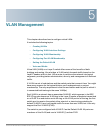
VLAN Management
Configuring VLAN Interface Settings
Cisco Small Business SG200 Series 8-port Smart Switch 105
5
To configure VLAN interface settings:
STEP 1 Select the port or LAG to configure and click Edit.
STEP 2 Configure the following settings for the selected port or LAG:
• Interface VLAN Mode—Select an option to configure the port type with
respect to VLAN membership and tagging.
- General—The port can be a member of one or more tagged or untagged
VLANs. This mode allows the full capabilities specified in the IEEE 802.1Q
specification, “VLAN Tagging.”
- Access—The port can accept only untagged frames. An access port can
be a member of only one VLAN and it uses the VLAN ID as its port VLAN
ID (PVID). Access ports are typically used to connect hosts, which
become members of the VLAN by virtue of being physically connected
to the port.
- Trunk—The port can be assigned to only one untagged VLAN, the native
VLAN, and can be assigned to any number of tagged VLANs (or none).
Trunk ports carry traffic for multiple VLANs from the switch to other
network devices, such as an upstream router or an edge switch.
• PVID—(General ports only) The port VLAN ID indicates the default VLAN
that the interface is a member of. Set the PVID equal to a VLAN ID where the
port is an untagged member. (For Access ports, the PVID is automatically set
to the Access VLAN ID. For Trunk ports, the PVID is set to the configured
Native VLAN ID or, if None is configured, to the default VLAN ID.)
• Native VLAN—(Trunk ports only) The native VLAN identifies the one
untagged VLAN membership for a trunk port. Select one of the following:
- None—The port has no untagged VLAN membership. The PVID for the
port is set to the default VLAN ID.
- Default—The Native VLAN equals the default VLAN. The PVID for the
port is also set to the default VLAN ID.
- User defined—The VLAN ID you specify is used as the untagged VLAN
membership for the Trunk port. The PVID for the port is also set to the
specified VLAN ID.
• Access VLAN—(Access ports only) An access port can be a member of
only one VLAN, the Access VLAN. The port VLAN ID is set to the Access
VLAN ID.


















